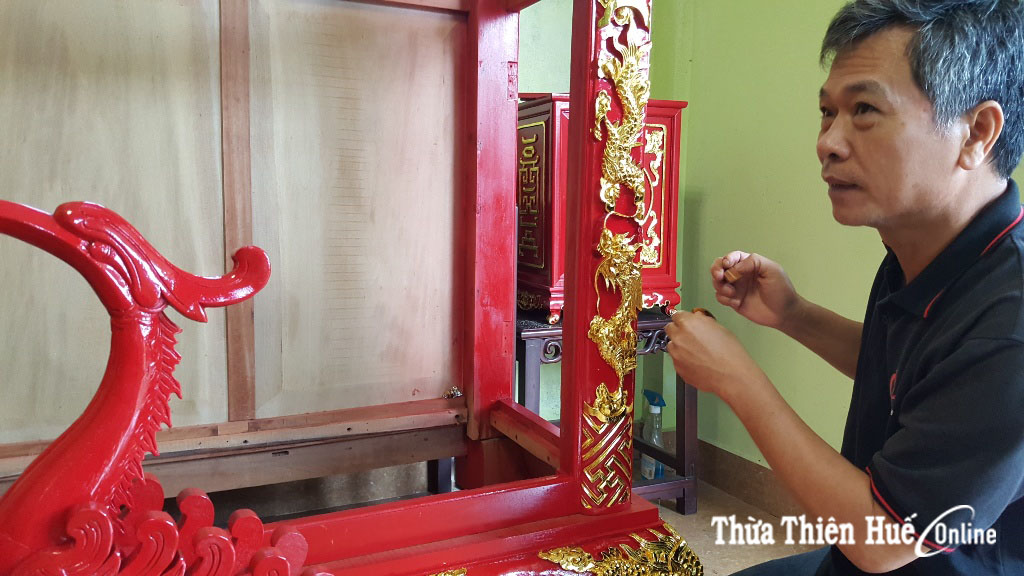.jpg)
Mr. Le Cong Viet, well known for horizontal lacquered boards, parallel sentences, and decorative screens in worship space
Where the elite gathers
Mr. Tran Dinh Hang, head of Vietnam National Institute of Culture and Arts in Hue, said besides serving as wooden objects for worship, horizontal lacquered boards and parallel sentences remind descendants of their origin, teaching them about filial piety, conducts and aspiration for prosperity.
Although Hue is not the birthplace of wood carving, it was in the imperial capital where many talented artisans gathered to serve in royal palaces during the Nguyen's times. They left priceless wooden artworks, including horizontal lacquered boards and parallel sentences.
At that time, besides skillful workers selected to serve in Doanh Thien Ty (Moc thuong), there were their relatives and apprentices working for mandarins everywhere. Accordingly, younger generations who continue producing horizontal lacquered boards and parallel sentences keep appearing.
Carving career can be found in many places throughout the province. As recorded, My Xuyen Village in Phong Hoa, Phong Dien boasted such skillful carving artisans as Nguyen Due, Nguyen Tram , Le Do Tuy, etc. who helped hand down the career through generations.
The name Phan The Hue has always been mentioned as the "golden hand" of traditional wood carving in Pho An, Phu Duong, Phu Vang though he passed away. Besides, the artisan Le Hoang Khanh in My Xuyen Village, Phong Hoa Commune (Phong Dien) and many others have left priceless cultural values which are in existence now.
For nearly 40 years, the familiar sounds of people carving have been heard in the small house in Pho An Village (Phu Duong.) It is the house of Phan The Lam, the only son of Phan The Hue who follows in his father’s footsteps. His products can be seen at ancestral houses in Quang Cong, Quang Ngan (Quang Dien) and Phu Thuan (Phu Vang).
Recently, the horizontal lacquered board named "Vietnamese Origin" exported to the U.S. received lots of compliments from the oversea Vietnamese community. It is Phan The Lam who meticulously carved and gilded and lacquered. For a man with nearly 40 years following in his father's footsteps with so many works, big and small, it is a joy.
Le Cong Viet, a sculptor with more than 30 years of experience in the carving village of My Xuyen, Phong Hoa (Phong Dien) impresses people with many works in Thua Thien, Quang Tri and South-West Vietnam. His first works that marked the turning point in his career of letter carving is the horizontal lacquered boards, the parallel sentences and the dragon gates at Tu Dam Pagoda in Hue, made in 2001. His works are too many to be counted. Some of his are displayed at Nguyen Tri Phuong worship house (Phong Chuong, Phong Dien), the 2,000 m2-wide worship hall in Cu Chi (Ho Chi Minh City), the worship hall in Long An, etc.

Mr. Phan The Lam with a passion for carving, gilding, and lacquering
Endless nostalgia
"The most important step in the process of making a horizontal lacquered board and a pair of parallel sentences is sketching on wood. The drawer is like a head architect. It is inconvenient if he has to rely on others for that step which shows the skillfulness of the sculptor. Next comes the pruning stage which requires creativity. Every step needs attention. Just a minor mistake leads to failure,” according to Mr. Le Cong Viet.
This job requires meticulous and hard work. It is the ancestry respect that gives workers confidence and optimism. Nostalgic people and Hue natives living far away from home are very interested in this original art of making worship objects, including horizontal lacquered boards and parallel sentences.
Wooden art works reveal the talent of artisans working for the system of imperial works in Hue which were well supervised and received uniform treatment throughout the country. In order to preserve this art and to make sure about the quality of products, it is necessary to establish a handicraft workshop right in the Imperial City taking care of producing, reproducing, exchanging and consuming.
Story and photos: Hoai Thuong